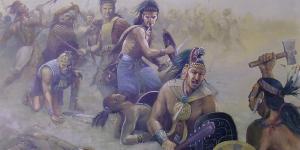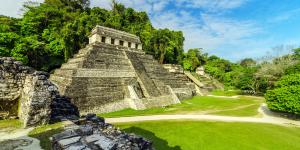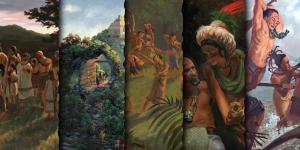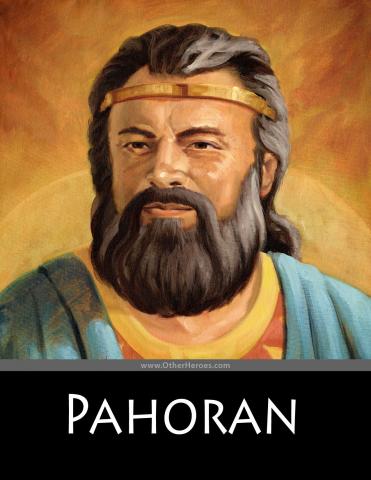You are here
Book of Mormon Central is in the process of migrating to our new Scripture Central website.
We ask for your patience during this transition. Over the coming weeks, all pages of bookofmormoncentral.org will be redirected to their corresponding page on scripturecentral.org, resulting in minimal disruption.
Gospel Doctrine Lesson #33: A Sure Foundation

Scripture Block
Helaman 1-5
To encourage class members to build their testimonies on the foundation of Jesus Christ.
Lesson Manual
KnoWhys

Why Did Helaman Compare Christ to a Rock?
Helaman 5:12
Articles
Helaman 2
Daniel C. Peterson, "The Gadianton Robbers as Guerilla Warriors," in Warfare in the book of Mormon, edited by Stephen D. Ricks and William J. Hamblin (Salt Lake City: Deseret Book/Provo, Utah: Foundation for Ancient Research and Mormon Studies, 1990).
The beginning of Helaman is where we first encounter the Gadianton Robbers. Daniel Peterson discusses the war tactics of the Gadianton Robbers in light of ancient warfare practices.
Helaman 3
"Cement and the Book of Mormon," FAIR Mormon entry.
This entry provides evidence that cement in the Book of Mormon is not anachronistic and was in fact used in Mesoamerica.
"Cement in the Book of Mormon," Maxwell Institute for Religious Scholarship. August 2000.
This short article also provides additional evidence on cement used in Mesoamerica and its use in the Book of Mormon.
Matthew G. Wells and John W. Welch, "Concrete Evidence for the Book of Mormon," in Reexploring the Book of Mormon, edited by John W. Welch, (Provo, UT: FARMS, 1992), 212-214.
This chapter of Reexploring lays out evidence for the use of concrete and cement in pre-Columbian Mesoamerica.
John L. Sorenson, "Mesoamerican in Pre-Spanish South America," in Reexploring the Book of Mormon, edited by John W. Welch, (Provo, UT: FARMS, 1992), 215-217.
In Helaman 3:8, it tells of people that spread to the land northward and the land southward. This article proposes that Book of Mormon peoples could have spread across the entire American continent, and not simply remained in a limited geographic scope.
John L. Sorenson, "Mesoamericans in Pre-Columbian North America," in Reexploring the Book of Mormon, edited by John W. Welch, (Provo, UT: FARMS, 1992), 218-220.
Helaman 3:8 says that the people spread from the sea south to the sea north. Today, archaeologists, linguists, and historians who have studied the matter are agreed that a long sequence of cultural transmissions and migrations moved northward from southern Mexico.
John L. Hilton, "Wordprints and the Book of Mormon," in Reexploring the Book of Mormon, edited by John W. Welch, (Provo, UT: FARMS, 1992), 221-226.
Helaman 3:13 claims that there were many records, and that they were made by many people. This article discusses the wordprint studies that have been done on the text of the Book of Mormon to demonstrate how multiple authorship can indeed be attested.
John L. Sorenson, "Worth Repeating: The Book of Mormon as a Mesoamerican Record," Insights 27, no. 5 (2007).
Helaman 3:15 tells of “many books and many records of every kind” among his people in the first century BC.. The Nephite account is a record that resembles in form, nature, and functions what we would expect in an ancient Mesoamerican codex, a type of document that was utterly unknown to Joseph Smith.
John A. Tvedtnes, "Book of Mormon Tribal Affiliation and Military Castes," in Warfare in the Book of Mormon, edited by Stephen d. Ricks and William J. Hamblin (Salt Lake City: Deseret Book/Provo, Utah: Foundation for Ancient Research and Mormon Studies, 1990), 307.
This article suggests how Jaredite "secret combinations" may have reached the Nephites through the Mulekites, since they originally occupied territory previously held by the Jaredites. This article also explores the relationship between the Gadianton robbers and the king-men of decades before. They very well may have been the same group and they may have been Mulekites seeking to recover a lost kingship.
David R. Benard, John W. Welch, and Daniel C. Peterson, "Secret Combinations," in Reexploring the Book of Mormon, edited by John W. Welch, (Provo, UT: FARMS, 1992), 227-229.
In Helaman 3:23, the reader is introduced to the secret combinations of the Gadianton Robbers. Critics of the Book of Mormon have argued that "secret combinations" is a code word with reference to the Freemasons of Joseph Smith's day. This article discusses the various other uses of "secret combinations" in 19th century America and earlier.
John W. Welch, "Rollercoaster Economics," in Pressing Forward with the Book of Mormon: The FARMS Updates of the 1990s, edited by John W. Welch and Melvin J. Thorne (Provo, UT: FARMS, 1999), 180-186.
Helaman 3:25 describes the incredible economic prosperity of the Nephites during this time. This article explores the various reasons why the Nephite economy experienced such drastic and quick fluctuations.
Helaman 4
John L. Sorenson, "'A Day and a Half's Journey for a Nephite'," in Reexploring the Book of Mormon, edited by John W. Welch, (Provo, UT: FARMS, 1992)187-188.
Helaman 4:7 uses "a day's journey" to signify distance in the Nephites' fortifications against the Lamanites. Sorenson uses this information to make some conclusions about Book of Mormon geograpy and the "narrow neck of land."
"A Day and a Half's Journey for a Nephite," Insights 5, no. 1 (1985).
This article also provides information on the geographic lay of the land based on the phrase "a day's journey."
Andrew H. Hedges, "The Narrow Neck of Land," Religious Educator: Perspectives on the Restored Gospel 9, no. 3 (2008): 151-160.
In a more thorough treatment of the topic, Andrew Hedges analyzes the scope of the narrow neck of land in Book of Mormon geography, based off relative distance markers, such as a "day's journey" found in Helaman 4:7.
Helaman 5
David E. Bokovoy, "Repetitive Resumption in the Book of Mormon," Insights 27, no. 1 (2004).
Repetitive resumption refers to an editor’s return to an original narrative following a deliberate interlude. Another example of repetitive resumption in the Book of Mormon occurs in Helaman 5:5-14, in Helaman's powerful discourse to his sons Nephi and Lehi.
Matthew Roper, "Was Aminadab a Zoramite?" Insights 24, no. 1 (2004).
When Nephi and Lehi are miraculously saved in prison, the Lamanites and Nephite dissenters convert to the Gospel. One of these Nephite dissenters, Aminadab, may have been a Zoramite based off the teachings he remembers.
Additional Lesson Guides
LDS Living Gospel Doctrine Lesson #33
RSC Gospel Doctrine Lesson #33
Meridian Magazine Gospel Doctrine Lesson #33
GospelDoctrine.com Helaman 1, Helaman 2, Helaman 3, Helaman 4, Helaman 5
Feast Upon the Word Gospel Doctrine Lesson #33
Jim Faulconer's Notes on Gospel Doctrine Lesson #33














